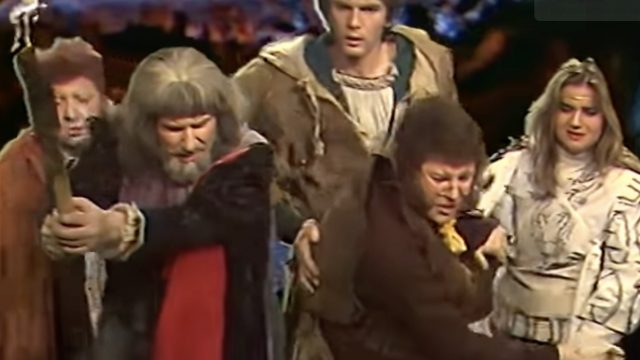The FAR magnaminously provides the absolute best in starring roles for hip-hop artists*, adaptations of The Lord of the Rings**, foreign language films***, cult movie screenings****, and streaming series*****.
Thanks to Ruck Cohlchez****** for contributing this week. Send articles throughout the next week to ploughmanplods [at] gmail, post articles from the past week below for discussion, and Have a Happy Friday*******!
* 1998 only
** 1991 Soviet Russia only
***As defined by the Hollywood Foreign Press Association and nobody else
****Closed to audiences
*****Experience may vary
****** Good dude
******* Sincere
At Vulture Jordan Coley praises the late DMX and his role in 1998’s Belly, which he dubs the FUBU of American cinema:
Critics hated Belly, but there’s a reason people like me could quote the film without ever having seen it. The score is about as good as it gets. From the stunning “Back to Life” a cappella cue in the opening sequence to the Sean Paul and Mr. Vegas cameo in Kingston, to Sister Nancy’s “Bam Bam,” booming in a dimly lit Jamaican bar as the camera hovers on the glistening sweat, clinging to a woman’s bare thighs — you could write a book on it. Perhaps most impactful of all, the film gave many a fitting first introduction to DMX, the only person with enough bark to bring Buns to life, but a man whose pain, introspection, and verve far outpaced anything a movie character could offer.
For Little White Lies, Ian Wang contextualizes Minari in terms of other films examining the Asian-American experience and how they were received in terms of “Americanness”:
Minari is less politically trenchant than Hito Hata, but they both exist within a framework of independent Asian-American filmmaking which looks past the desire to appeal to the white gaze, to assimilate into a system that was never built for them. To give another example, Justin Lin’s 2003 crime drama Better Luck Tomorrow follows a group of teenagers who have, to all intents and purposes, achieved the American Dream; they live in middle-class neighbourhoods and are on track to attend Ivy League universities. Yet they are disaffected, numbed by academic pressure, eventually seeking release through a string of petty crimes that ends in tragedy.
Langa opines for Popdust that new Amazon horror series Them exploits Black trauma for no gain:
After all, the show is part of an emerging genre of Black horror, which includes Jordan Peele’s Get Out and Us, as well as HBO’s fantasy/horror series Lovecraft Country. These iterations of the genre have played on common tropes in horror and in Black representation to subvert audience expectations and present new narratives. […] Instead of using racial tension to highlight the realities of being Black and facing the discrimination that was and remains rampant, Them asserts that Black life is just a series of violent traumas and suffering. The one-note tastelessness of the drama plays into the idea that Black people are defined by their pain.
Ella Kemp at Letterboxd talks to filmmaker Emma Seligman about the new feature version of her short, Shiva Baby, Jewish humor, and family expectations:
I felt like the world was telling me to be like “an empowered, independent, sexy woman who doesn’t care what anyone thinks of her, and doesn’t abide by any rules”, and I was like, “This is the opposite of being a nice Jewish girl!” And I just felt like those two things were screaming at me. So I did want to play on that. But I don’t even think it’s playing, just because that felt like what I was trying to battle within myself. And I think a lot of young people do, whether they’re Jewish or not. That’s their family’s expectations. And then the world is like, “But don’t care and don’t commit…”
An independent theater in Oregon refused to give up their streak of weekly showings of Rocky Horror Picture Show, playing the movie to an empty theater for 54 weeks until limited audiences could return. Samantha Swindler has the scoop for The Oregonian:
“I watched it alone. I watched it during the snowstorm,” said [projectionist Nathan] Williams, who serves as emcee for the theater’s “Rocky” nights. “I was in a position to keep a flame burning, to keep a torch lit. “I’m just a guy holding a torch for the city of Portland, for all the weirdos, for all the people who don’t have a safe place to call home, we’re home.”
Finally, Alan Yuhas reports on the sudden appearance on YouTube of a 1991 Soviet television adaptation of The Lord of the Rings that cut quite a few corners but nonetheless can offer a window into the era of its production:
[Author Mark] Hooker compared the production itself to a samizdat translation, “with all the rough edges.” Among them are wobbling cameras, as though the hobbits were filming their journey with a camcorder, and sudden cuts to a narrator who, smoking a pipe or smiling silently, sometimes seems content to leave his audience in the dark. The production includes some scenes from the books that are not found in the Jackson films, including one with the character Tom Bombadil and the creatures called barrow-wights. It also deviates in some ways, with the character Legolas played by a woman and no appearance of the monstrous Balrog. All these decisions are “fascinating” to Dr. [Dimitra] Fimi and her fellow scholars, she said, especially for “what that particular cultural moment is doing with that text.”

